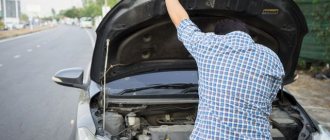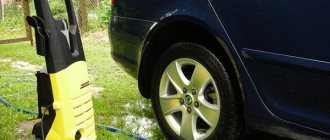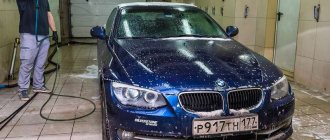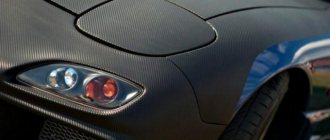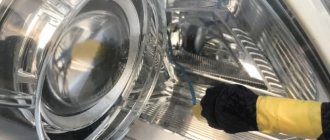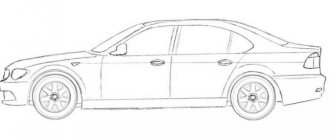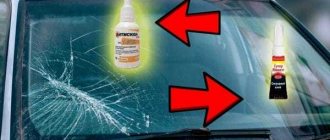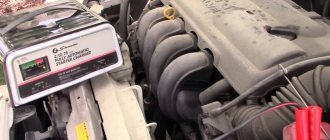Self-service car washes equipped with powerful professional equipment allow you to save money and time without compromising the quality of the wash . Knowing how to properly wash a car at a self-service car wash, you can remove even complex stains without damaging the paintwork, optics and plastic body kit for literally 100-300 rubles. A full cycle with washing not only the body, but also the rugs, vacuum cleaner and waxing will cost about 500 rubles.
In this article we will talk about the optimal sequence of operations for a self-service manual wash at different times of the year, the main car wash modes and other features that will allow you to wash your car quickly, safely and at minimal cost.
How does a car wash work?
Self-wash control panel
A standard self-service car wash consists of several isolated stations equipped with high-pressure apparatus and spray guns for supplying water, detergents and air. There are usually two guns: one is used for applying foam , the other for everything else. Some car washes have a third one, equipped with a brush to remove difficult dirt . The compressor and vacuum cleaner are most often located outside the washing box in a separate unit .
Each box has a control panel for selecting modes with a payment terminal with a bill acceptor, a coin acceptor and/or a card reader. Sometimes, before washing your car at a self-service car wash, you must first add money to your car wash card or purchase tokens.
You will find detailed instructions on how to use the self-service car wash in the next section. The table below will tell you about the features of the modes at a self-service car wash.
Self-service car wash modes
| Mode | What is it/how does it work | Why is it needed? |
| Rinse/water | Ordinary tap cold (warm in winter) water supplied under pressure of about 140 bar. | For washing off difficult contaminants and pre-rinsing the car. |
| Soak/pre-wash (not available at all sinks) | Low pressure detergent. Recommended for use in winter or when the body is heavily soiled. | For dissolving complex stains. |
| Active chemistry/foam | Foamed active detergent. Apply to a dry car, usually with a shorter, thicker gun. The optimal holding time on the body is 2–3 minutes. | To dissolve contaminants and separate them from the body. |
| Shampoo water | Water with dissolved detergent. It is fed under pressure from the main gun, washes away the foam, the dirt dissolved by it, and removes remaining contaminants. | For washing a slightly dusty body, for complete cleaning of the body after washing off the foam. |
| Sink with brush | Water with detergent, supplied by a special gun with a brush at the end. Used for wiping off particularly stubborn dirt, treating wheel rims and body kits. | For removing heavy contaminants that cannot be washed off with water pressure, as well as cleaning hard-to-reach places. |
| Final rinse / purified water / osmosis | Water purified from unwanted impurities. Usually applied with the main gun, at the last stage of washing. | To prevent stains and streaks after rinsing |
| Waxing | Liquid wax solution. Applied with a main gun, it forms a transparent protective film on the body. | To add shine, create a hydrophobic effect and protect against subsequent contamination. |
| Air | Supplied with a separate gun, it blows water out of hard-to-reach places. | For removing water from lock cylinders, seals, exterior mirrors, etc. |
Advantages
Next, let's look at why waxing is necessary and what the main advantages of its use are:
— The paintwork shines well after treatment;
— a protective wax film does not allow the coating to deteriorate;
— a car covered with it washes better;
- protects paintwork well from pollution, chemicals and UV rays.
Hi all! It's time to write the first post. Actually, it should be about how I chose wheels and tires for the winter. The re-shoeing took place, but the post did not write itself. I promise to write a report in the spring about which wheels and tires I chose and how they performed.
And now the story will be about car washing followed by wax polishing. I plunged headlong into the topic, fortunately there was a lot of information, Drive2 and Youtube were especially helpful. In my search, I even came across a forum for car wash owners. If anyone needs it, I’ll look for the link, it’s a fascinating read.
Step-by-step instructions on how to wash your car at a self-service car wash
How to wash a car at a self-service car wash in stages directly depends on the degree and nature of contamination, as well as the available operations.
Recommended sequence of washing modes
Standard sequence of modes for regular washing:
- Soaking - the body is wetted with water or detergent to soften the dirt.
- Main wash – the car is treated with active foam that dissolves dirt.
- Rinse – the reacted foam is removed from the machine.
- Application of liquid wax - the body is treated with a coating that repels dirt and adds shine.
- Final rinse – removing excess liquid wax with filtered water.
- Drying and wiping - locks and gaps are blown out, residual water is removed from the surface of the body and glass.
Typically, the modes on the control panel are arranged in the recommended sequence. For the best washing efficiency, you can adhere to this algorithm.
If after a single application of detergent and rinsing there are still dirt on the body, you can repeat the procedure or use a soft sponge to remove them.
How to properly wash a car at a self-service car wash: step-by-step instructions
How to wash a car at a self-service car wash: video
- Removing the mats . Before you start washing, you need to remove the rugs from the interior by hanging them on special clothespins. All modes are not required for rugs - just apply foam and rinse with plain water. It is better to soak and rinse the rugs at the very beginning, immediately after selecting the appropriate mode. It is more convenient to do this while washing the car, walking around it in a circle.
- Pre-wash . The task of this stage is to prepare the body for the application of the main detergent, soften dirt and/or cool the heated paintwork. Depending on the availability of appropriate modes, the car is washed with ordinary water or water with shampoo from top to bottom. If there is minor contamination, we skip this step.
- Main wash . Designed to soften and remove stubborn dirt. Foam is usually applied with a separate gun from bottom to top - this will allow it to stay longer on the body, the order of movement is from the hood and around, the foam is applied to the hood last (on a hood that is hot from the engine, the foam dries faster).
- Pause .
After applying the foam, you need to take a break, since it will not be possible to properly wash the car at a self-service car wash without keeping the detergent on the body. Depending on the degree of activity of the chemical and the amount of dirt, the pause should range from 1–2 (relatively clean car) to 3–5 (if very dirty) minutes. If the pause is limited in time or paid, in order to save money, you can pay the fee in stages, calculating the time so that it ends at the moment the foam is applied. - Sink with brush .
If the car is heavily soiled and there is a special gun with a brush at the car wash, you can remove stubborn dirt by applying a shampoo solution and simultaneously wiping the body with a brush. With strong pressure, the brush scratches the paintwork! If there is no heavy contamination, skip this step. - Rinse . After a pause for allowing the foam to soak, or brushing, you need to rinse off the detergent with cold or warm (depending on the season) water, not forgetting to go over the wheels, arches and other hard-to-reach places where dirt often sticks.
- Protection .
When the car is already clean, you can apply a wax coating to it (it can be on the “wax”, “shine” button, etc.). The solution of the protective substance forms a thin film on the body, giving it shine and repelling dirt. Before washing your car at a self-service car wash with wax, make sure it is thoroughly rinsed. If the dirt is not completely washed away, the protective coating will preserve it, and during subsequent washes it will be more difficult to remove these contaminants. - Final rinse .
After waxing your car, you need to remove excess wax using purified water (osmosis). Due to the absence of impurities, it dries faster and does not leave unwanted sediment, streaks and stains. Do not neglect osmosis, even if you skip the “Protection” mode, since it is difficult to wash your car at a self-service car wash without streaks with ordinary water. - Drying and blowing . If you have a gun with air, you can blow out locks, openings, and gaps to drive out any remaining water. It is especially important to do this in the cold season, otherwise water may freeze in the cavities in the future.
To quickly dry the body, you can wipe it with a microfiber or faux suede cloth, but not with an ordinary rag. At most car washes it is prohibited to do this in the box - there is a special area for this. Often an “air unit” is installed there, equipped with a vacuum cleaner for cleaning the interior, and a compressor for blowing hard-to-reach places. But if wax is applied, then you should not rub the car too much, so as not to wash off the protective film.
What not to do at a self-service car wash
In order not to harm your car, remember about unacceptable manipulations at a self-service car wash:
How to properly wash an engine, top 5 mistakes: video
- Do not bring the gun closer than 30 cm to avoid damaging the paintwork.
- Do not be overzealous with the treatment of defective areas of the paintwork that have chips, deep scratches, or saffron marks, so as not to tear off the paint under pressure.
- Do not direct the jet at an acute angle relative to trims, moldings, nameplates and other external decorative elements, so as not to tear them off.
- Do not scrub dirty areas with a rag or napkin because dirt particles stick to it and act as an abrasive.
- When washing the engine (unless it is prohibited by the rules, it is often strictly prohibited to do this) do not direct a powerful jet at the intake elements (filter housing, pipes, throttle), wires and electronic components.
- Do not wash a hot engine, because sudden temperature changes can lead to the formation of microcracks and metal deformation.
- Do not direct a powerful flow at the radiator so as not to jam its lamellas.
In addition to the degree of contamination, the time of year also affects the washing process. Read below about how to properly wash your car at a self-service car wash in winter and summer.
Operating principle
The operating principle of a dry car wash is as follows:
- Using a sprayer, an emulsion is applied to the body; it contains surfactants, a corrosion inhibitor, silicones and water.
- Silicone envelops dirt and dust, which deprives these components of their abrasive properties. As a result, the car body will not be damaged when removing contamination. Surfactants and a corrosion inhibitor prevent stains and dirt particles from remaining on the car.
- After treating the surface of the car, remove dirt with soft cloths. In some cases, it may be necessary to treat with polish and wipe the body with the same napkins.
Despite the ease of washing without water, it effectively fights minor dirt and dust.
For glass, other cleaning agents are used that effectively remove dirt, do not leave streaks and do not scratch the surface.
Differences between car washing at a self-service station in summer and winter
Summer and winter car washing differ in a number of nuances:
Explanation of the names of washing programs, click to enlarge
- In winter, warm water is used for rinsing, in summer - cold;
- in summer, organic contaminants additionally have to be removed from the body;
- in winter, dirt is mixed with reagents, which are especially deposited in arches, on sills and in other hidden cavities in the lower part of the body;
- In hot weather, it is advisable to pre-cool a heated body with cold water; when the air temperature is near zero, on the contrary, it needs to be warmed up before washing;
- in the warm season, the mats will dry without wiping, and in the cold season they need to be wiped dry so that moisture does not linger in the cabin, otherwise the windows will fog up.
Read more about these and other features of visiting a self-wash in winter and summer below.
How to properly wash your car at a car wash in winter
Before washing your car at a self-service car wash in winter, pay attention to the air temperature. When it is below -5 °C, it is advisable to postpone water procedures. If you cannot do without washing, follow the recommendations:
How to properly wash a car at a self-wash in winter: video
- Choose a sink with heated boxes . Avoid pavilions that are blown in front and behind, since washing your car at an open self-service car wash in cold and windy weather is undesirable.
- Don't rush to wet the car right away . Stand in the heated box for a couple of minutes so that the body warms up a little.
- Use warm water . Soften dirt, ice and road chemicals with a stream of heated water. Rinse the body with it to remove foam.
- Process the bottom carefully . In winter, roads are sprinkled with anti-icing agents; prevent them from depositing in the lower part of the body.
- Apply wax after washing . The protective coating prevents water from lingering on the body and serves as a de-icer.
- Blow out locks and gaps . After washing, blow out door locks and handles, body gaps and seals with compressed air to prevent water accumulated underneath them from freezing.
- Do not park your car immediately after washing . It is advisable to drive with the heater on so that the heat coming from inside will speed up the drying. You can even turn on the heater and heated rear window before starting the wash.
At negative temperatures below -10°C, it is better to visit a classic car wash, where the car will be washed and dried in a heated room.
How to properly wash your car at a self-service car wash in summer
In the summer, adjustments to the washing process are made by heat and contaminants of plant and animal origin: pollen, berry juice, tree resins, insects. For more efficient cleaning:
Applying wax after washing protects the body from the adhesion of dirt and prevents corrosion, thereby simplifying the entire washing process
- Do not apply foam to a hot body . It dries quickly, making it less effective at removing dirt and making it more difficult to wash off. To cool, spray the body with plain water or water with shampoo. This is especially true for dark-colored cars, which in the sun warm up to +50 degrees or more.
- Do not overexpose the foam . To prevent the detergent from drying out, it should be left in the heat for no more than 2-3 minutes.
- Use wax . The protective coating will prevent the remains of insects, pollen, resins, berry juices, bird droppings and other aggressive dirt from being eaten into the paintwork.
- Don't neglect the final rinse . In hot weather, water dries out quickly, and the dissolved minerals contained in it do not have time to drain. Be sure to rinse the body with demineralized water to prevent streaks.
Kazakhstan:
| KazPost | 250 rub. | Cash. No commission! (%) | |
| 1) By courier to the door 2) To the Post Office. | |||
Payment by bank transfer (by invoice) for legal entities. persons from 100 tr. — More >>>
Return conditions:
Automotive chemicals are products that cannot be returned or exchanged, so you can be confident in the quality of the products because... There is no possibility of replacing a product originally sold by us with a damaged one or replacing it with a product that was not purchased at all in our store. All products are stored in the correct temperature conditions and cleanliness.
Lifehacks and subtleties on how you can save money on self-washing
On average, a self-service car wash costs car owners less than a regular car wash. But significant savings can only be made with the right approach to minimize costs. Using the tricks below, you can wash your car at a self-service car wash for 100 rubles.
Tricks for saving money at a self-service car wash:
How to wash a car for 100 rubles at a car wash with one gun: video
- Break your money into small bills . Before you go to the car wash, prepare some change or use the exchange service at the administrator. With small bills or coins, you can pay separately for each service (shampoo, foam, water), with pauses between them.
- Bring a helper . Ask an assistant to insert banknotes and press buttons, while you pick up the sprayer and apply pressure. This way you can save a dozen or two seconds.
- Take the gun in your hands before starting the program . Taking the gun before pressing the button will also save time and money.
- Use a bucket of water and a sponge .
Having filled a bucket of clean water (the tap with it is often free) and taking a large-pored sponge, while waiting, you can additionally rub the dirtiest areas for subsequent quick rinsing. Rinse the sponge often in clean water to prevent dirt particles adhering to it from scratching the varnish. For the same reason, do not use rags and napkins, as abrasive substances (earth, sand, salts) remain on their surface and cause scratches!
Always start with the rugs so they have time to dry by the end of the wash.
- When working with an assistant, start washing near the rugs . You need to apply the foam and rinse it off from the place where the clothespins for the rugs are located. They need to be treated first so that by the end of the wash the water has time to drain and dry.
- Alone, start washing your car near the terminal . If there is no assistant to press the buttons, wash the car in a circle away from the terminal. Then, having walked around it all, you can pause it faster.
- Don't overuse pauses . You should not press pause too often (for example, to manually scrub away stubborn dirt), because the pump needs time to develop full pressure. Between pressing the gun and applying working pressure, a couple of seconds often pass, and during washing with frequent pauses, you can lose a dozen or two seconds of time.
- How to extend the pause ? It happens that a pause of 120 seconds is not enough, then you can press any mode (foam, wax, etc.) and immediately press pause again, no money will be spent. This can be done 3 to 5 times, which is very useful when maintaining foam on the body or preparing for some stage.
- Do not use all modes unless necessary . If you wash regularly and there are no complex stains, you do not need to apply wax and pre-soak every time.
- Keep a couple of small bills in reserve . It often happens that there are not enough small items to complete the wash properly. Therefore, do not rush to feed dozens to the machine at the very beginning; leave 10–50 rubles for such a case.
- Wash your car more often . The desire to save on the number of washes can lead to the formation of dirt deposits that will be more difficult and take longer to clean. It is optimal to wash your car once a week. Regularly washing off small dirt and having the skills to use a washing gun allows you to wash your car at a self-service car wash even for 50 rubles.
By resorting to these life hacks, you can stay within a minimum budget and still get a good car wash. After all, the faster you move around the car, the cheaper it gets. If you're visiting for the first time, it won't be cheap. Also, don’t forget to wear something comfortable, so you won’t get dirty or wet when washing it yourself!
Is it possible to wash a car yourself?
Having decided to save on calling specialists and try the technique yourself, first study the technique by watching videos on the Internet and study the instructions for using the products. Incorrect use and excessive rubbing will result in scratches and streaks. Remember that a dry car wash cannot replace a regular water car wash. To keep your car clean and its paintwork intact, you need to wash your car in the classic way at least once a week, and use dry wash products in between. At the same time, you should not wash your car with special products more than once every two to three days.
Answers to frequently asked questions
How long does it take to wash a car?
You can apply foam to the body in 1–3 minutes, depending on the size of the car. The same amount is spent on washing it off. Wait 2-5 minutes between applying the detergent and removing it. Therefore, the estimated time for washing a car is approximately 10 minutes. It will take another 20 minutes to wipe the body. Be prepared for the fact that the first time washing will be longer and more expensive than planned.
Is it necessary to use all station modes?
It is necessary to use all modes of the station in order to thoroughly wash a heavily soiled car. If the goal is to wash quickly or remove dust, you can limit yourself to only foam and clean water.
Is it possible to damage a car's paintwork with pressure?
The pressure of the water jet at a car wash reaches 150 atmospheres, so it can easily damage paintwork. To prevent this, do not bring the gun too close (less than 30 cm) and do not overdo it with pressure if the paintwork has minor defects (chips, “saffron caps”).
Can I wash my engine at a self-wash?
Whether the engine can be washed at a self-service car wash depends on the rules of the particular establishment. Unless prohibited, you can wash your engine at a self-service car wash, following standard rules and precautions.
Do I need to wipe down my car after waxing?
It is not necessary to wipe down your car after applying the liquid wax, but using a microfiber cloth will help add an extra shine.
conclusions
A self-service car wash will be useful for people who save time and money and prefer to take care of their car themselves, with minimal access to other people. In addition, a self-service car wash will allow you to avoid wasting time in queues that usually occur at car washes with staff. And yet, such a service is not suitable for every car owner.
For some, even the simple steps indicated in the instructions will be too burdensome. Such people prefer to trust everything to specialists. In some self-service car washes, a significant drawback is the low concentration of chemically active elements in car chemicals.
And finally, the most important property of self-service car washes is that they are more suitable for lightly dirty cars. It is better to go to such a car wash after the road, when the dust, dirt and snow are still fresh. In the case of an old layer of dried dirt, a standard car wash is most suitable. However, it is worth trying this new type of service, if only out of curiosity. Good luck and easy travels!
Instructions for use
With the help of the following tips, you can understand how to do the work yourself.
- First you need to assess the degree of contamination of the car body. If there are large pieces of dirt, you need to get rid of them using ordinary water. Do not expect that you will be able to clean the body of a thick layer of dirt using the technology in question. But the water consumption will obviously be less compared to a conventional sink. You will also need water to wash dirty towels that remain after dry washing. Washing is simple - soak in hot water, adding a little dishwashing detergent or liquid soap.
- A microfiber towel should be folded into four. As a result of this, you will get 8 sides, which must be applied gradually.
- Shake the cleaning product so that all ingredients are well mixed together.
- Washing is done from top to bottom. It is advisable to start with the roof and move on to the windows, hood, trunk lid, doors and bumpers.
- It is advisable to divide large body elements (hood, roof) into several segments and wash them separately.
- Apply a sufficient amount of product to the body element so that the dirt is well saturated. There should be no dry areas. Wait 10-20 seconds, apply the product to a towel and begin wiping the part.
- At the first stage, we wipe the body part in a horizontal direction, practically without pressing. You need to move slowly and only in one direction. Otherwise you'll just be stirring up dirt. During the next pass, you need to lightly press the towel, which will help remove the remaining dirt particles. A good solution is the “snake” movement.
- After each stage, you need to remove the towel and open the clean side. After using each of the 8 sides, take a clean towel.
- After removing the dirt, wipe the surface of the part dry using a separate microfiber towel.
- There is no need to apply a lot of product to the glass, since it contains wax, which can cause unsightly stains.
- Wheels should be washed with separate towels. Note the presence of dust from the brake pads on the wheels, which can very quickly scratch the body.
Types of funds
The main ingredient in dry washing is a chemical. It must be stored at a positive temperature. You can buy additional products in stores to remove bird droppings, bitumen and other stubborn contaminants.
When choosing a chemical, read reviews about it. A low-quality product at a low cost will damage the surface.
You can buy ready-made kits for sale, including the product itself, polish and wipes. In addition, aerosols are sold for cleaning windows, headlights and streetlights.
Towels and napkins will be required separately for cleaning dirt and for polishing the surface. This ensures that stains are removed and the polish is distributed evenly. Towels must have long pile, otherwise dirt will be smeared across the surface. It is recommended to purchase microfiber with a density of more than 300 g/m.
